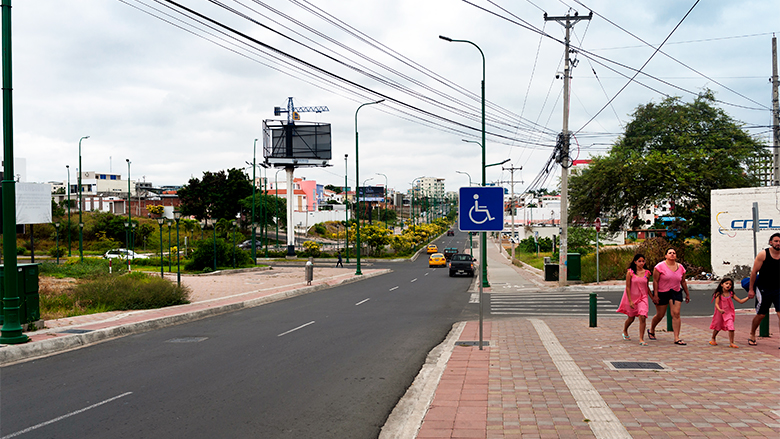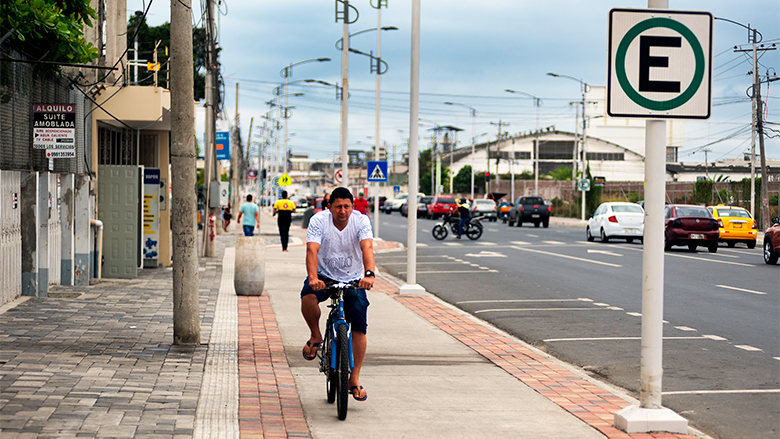Mobility to Improve Accessibility
“You have to recall what the city was like before the project,” said Roger Gorham, senior transport economist at the World Bank and co-manager of the Manta Public Utility Improvement Project. “Much of the city was not pedestrian-friendly. There were broken sidewalks, barriers, and a lack of organized parking.”
The city’s downtown areas were not easily accessible. Fortunately, the opportunity to improve sanitation systems allowed the project to address this issue as well.
“This project has enabled areas with water and sanitation works to also improve roads to avoid inconveniencing the population twice,” said Iris Marmanillo, a senior water supply and sanitation specialist at the World Bank and manager of the Manta Public Utility Improvement Project.
The project made improvements to the Barbasquillo road, 13th Street, 24th Avenue and Flavio Reyes Avenue, as well as to 4 de Noviembre Avenue and 113th Avenue, among others.
"One of the oldest commercial streets in Manta – 13th Street – was completely redone,” said Raúl Arboleda, project manager for the Manta government. “Sewage and water lines, as well as electric cables, were installed underground, eliminating overhead lines. The installation of LED streetlamps, colored paving stones, plants, benches and equipment completed the renovations. This nearly one-kilometer street was the first to be renovated with World Bank financing.”
As a result of this urban renewal, the city has undergone a constant and surprising transformation. On Barbasquillo road, significant private investment has included luxury hotels, restaurants, commercial and cultural centers, as well as sports areas. This renewed section of Manta has become a favorite among residents for walking, cycling and socializing.
“The Barbasquillo road’s open drainage channel was also covered. Those things are not just a matter of aesthetics, but of fundamental accessibility. Cities grow; they survive thanks to accessibility,” said Gorham.
This introduction of vitality was replicated in the other areas improved in the city center.
"Underground containers and cables, parking lot islands on every block, planters and benches, along with improved drinking water and sewage management, were all added” said Arboleda. "These increase the value of properties in the area. Look at the businesses now; you see an economically active city, even as we are emerging from the pandemic.”
The World Bank-funded project suffered two unexpected blows: a major earthquake in 2016 and the arrival of the Covid-19 pandemic in 2020. Nevertheless, city authorities managed to fulfill their commitments thanks to the World Bank’s flexibility and adaptability in terms of implementation of the works.
“Overall, the Bank tries to be flexible in the use of resources to enable rapid change in response to situations such as the pandemic or the earthquake. This project has seen many such challenges,” said Gorham. He said that the Manta experience led the World Bank to include a component for situations of this type in other projects of the region.
“Other countries learned from this experience. For example, the hurricane projects in Central America included emergency-response components from the start and we were able to mobilize resources very quickly.”
The financing also enabled local authorities to create new management models that transformed public administration into a more executive agency. Manta Mayor Agustín Intriago believes that this project strengthened public administration.
“Without a doubt, it strengthens it from several perspectives, first because of new forms of resource management, and secondly because of the capacity needed to respond to every requirement of an important multilateral organization such as the World Bank. Today, the establishment of a specialized project management unit has enabled us to manage other projects with other multilateral agencies and to do so with the certainty that results will be possible.”
The urban renewal of Manta improved mobility in critical points of the city, with a focus on accessibility of all residents.

"Mobility is a way to improve accessibility, that is, to help people reach shops, jobs, services and recreational opportunities, and to socialize with others with the least inconvenience possible,” said Gorham.
“Everyone is entitled to accessibility. That means we have to think about certain groups, understand their needs and try to improve it for everyone. Once you have this, the city can begin to experience that accessibility.”


